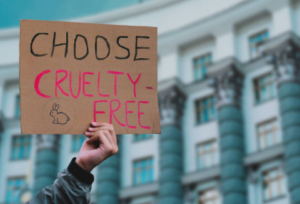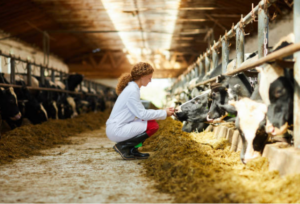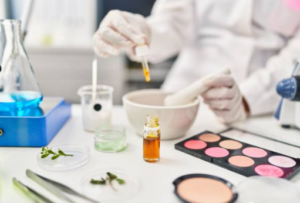Factory Farming Exposed

In the world of beauty, we often find ourselves immersed in skincare regimens, makeup routines, and self-care practices aimed at enhancing our outward appearance and boosting our inner confidence. These beauty rituals are deeply personal and can reflect our values, from embracing cruelty-free products to advocating for sustainability and environmental responsibility.
However, beauty extends far beyond what we see in the mirror. It encompasses the choices we make in our daily lives, particularly the products we consume and the impact they have on the world around us. One critical but often overlooked aspect of our choices lies at the intersection of the beauty industry and the ethical awareness that is increasingly shaping consumer preferences.
Factory farming, an industry designed to meet the growing global demand for meat, dairy, and eggs, has come under intense scrutiny in recent years. While its primary goal is to produce vast quantities of animal products, it also brings to light pressing ethical and environmental concerns that touch every facet of our lives, including our beauty choices.
This blog aims to expose the harsh realities of factory farming and shed light on how our beauty and skincare choices can inadvertently support or challenge this system. The objective is to encourage informed consumer decisions that contribute to a more sustainable, compassionate, and harmonious world—one where the pursuit of beauty aligns with the values of ethical, humane, and environmentally responsible practices.
The Factory Farming Model
Factory farming, often referred to as industrial agriculture, represents a major shift in how we produce the food we consume. It’s characterized by large-scale, highly mechanized operations focused on optimizing productivity and minimizing costs. The primary goal is to produce a massive quantity of animal products, such as beef, pork, chicken, and dairy, to meet global demands.
- Intensive Livestock Production: Factory farming is synonymous with intensive livestock production. This means that animals, whether they are chickens, pigs, cows, or turkeys, are raised in large numbers in confined spaces. These spaces are designed to maximize efficiency, often to the detriment of animal welfare.
- High Stocking Density: One of the defining features of factory farming is the high stocking density. Animals are crammed into small spaces, such as cages, crates, or pens, with minimal room to move. This overcrowding can lead to physical and psychological stress among the animals.
- Controlled Environment: Factory farms are designed to create a controlled environment. This includes the regulation of temperature, humidity, lighting, and even air quality. These controlled conditions are aimed at optimizing growth and productivity.

The Harsh Realities of Factory Farming
- Confinement and Overcrowding: In factory farms, animals are often subjected to cramped and unsanitary living conditions. Chickens, for instance, are frequently kept in battery cages, where they lack the space to stretch their wings or engage in natural behaviors like dust bathing. This overcrowding increases stress, aggression, and susceptibility to disease.
- Gestation and Farrowing Crates: Sows, used for breeding in the pork industry, spend a significant portion of their lives in gestation crates that are barely larger than their bodies. These crates are so restrictive that the sows can’t even turn around. After giving birth, they are moved to farrowing crates, which allow little more room, where they nurse their piglets through bars.
- Dehorning, Beak Trimming, and Tail Docking: Painful practices such as dehorning, beak trimming, and tail docking are common in factory farming. Dehorning is performed on cattle to prevent injuries and aggression but is often done without anesthesia. Beak trimming in chickens is intended to reduce cannibalism in crowded conditions, and tail docking in pigs is done to prevent tail-biting. These procedures are painful and stressful for the animals.
- Antibiotic and Hormone Use: Factory farms often use antibiotics to promote growth and prevent the spread of diseases in overcrowded and unsanitary conditions. Overuse of antibiotics in livestock can contribute to the development of antibiotic-resistant bacteria, a significant public health concern. Hormones may also be administered to promote faster growth and larger yields, raising concerns about their impact on human health.
- Lack of Outdoor Access: Many factory-farmed animals are denied outdoor access and fresh air. Poultry, in particular, are often raised in windowless sheds with artificial lighting to maximize growth. This lack of access to natural environments contributes to stress and behavioral problems among animals.
- Euthanasia Methods: Factory farming may involve inhumane methods of euthanasia, such as gassing or electrocution. These methods can cause undue suffering and distress for animals.
- Transportation Conditions: The transportation of animals to and from factory farms and slaughterhouses can be stressful and harsh. Animals may endure long journeys without proper food, water, or rest, leading to discomfort, injuries, and even fatalities.
- Environmental Impact: Factory farming contributes significantly to environmental degradation. It generates enormous amounts of animal waste, which can contaminate water sources and emit harmful gases into the atmosphere. Deforestation to make room for livestock farming is also a concern, leading to habitat destruction and loss of biodiversity.
- Animal Welfare Concerns: Factory farming prioritizes efficiency and production at the expense of animal welfare. Animals raised in these conditions often suffer from physical and psychological distress. The stress and discomfort can lead to health problems and injuries.
- Public Health Risks: Overuse of antibiotics in factory farming can result in the spread of antibiotic-resistant bacteria, posing significant health risks to both animals and humans.

The Beauty Connection
- Lanolin: Lanolin, a popular ingredient in many skincare products, is a waxy substance derived from the wool of sheep. While lanolin is a highly effective moisturizer, it’s often obtained from sheep raised in less-than-ideal conditions on commercial farms. These sheep may be subjected to practices such as mulesing, a painful procedure involving the removal of strips of skin, to prevent flystrike. By using products containing lanolin, consumers may indirectly support such practices.
- Collagen: Collagen is a structural protein found in the skin of animals, particularly cows and pigs. It’s a common ingredient in anti-aging skincare products, often marketed for its ability to improve skin elasticity. However, the production of collagen products can contribute to the demand for animal hides, potentially supporting factory farming practices that prioritize efficiency over animal welfare.
- Animal-Derived Glycerin: Glycerin, a common ingredient in skincare, can be sourced from animal fats. This can be a concern for individuals seeking cruelty-free and vegan skincare options. While some animal-derived glycerin is a byproduct of the meat industry, it’s crucial to be aware of the potential connection between glycerin in skincare products and factory farming.
- Squalene: Squalene, a compound often found in moisturizers, can be derived from shark liver oil. Although there are sustainable, plant-based alternatives available, products containing shark-derived squalene can contribute to overfishing and the decline of shark populations.

Making Ethical and Sustainable Beauty Choices
The beauty industry is increasingly responding to consumer demands for more ethical and sustainable products. Many brands are committed to cruelty-free practices, using plant-based ingredients, and sourcing their materials responsibly. By making informed choices and supporting these brands, consumers can align their beauty routines with their values.
- Read Labels: Be diligent about reading product labels and looking for cruelty-free, vegan, and plant-based certifications. These labels indicate that the product does not contain animal-derived ingredients and is produced without animal testing.
- Research Brands: Support brands that are transparent about their ingredient sourcing and ethical practices. Many companies proudly share their commitment to cruelty-free, sustainable, and eco-friendly beauty products.
- DIY Beauty: Consider exploring do-it-yourself (DIY) skincare and beauty product recipes using natural, cruelty-free ingredients. This allows you to have full control over what you apply to your skin and ensures you’re not indirectly supporting factory farming.
- Advocate for Change: Engage in conversations and support organizations and initiatives dedicated to animal welfare, sustainable beauty practices, and cruelty-free certifications. Your voice and choices can make a significant impact on the beauty industry’s shift toward ethical and sustainable practices
The beauty industry is inextricably linked to the larger issues of sustainability, ethics, and environmental responsibility. By embracing ethical and sustainable beauty practices, we can contribute to a more compassionate and harmonious world. Factory farming’s harsh realities serve as a reminder that our choices, even in the realm of beauty, can shape the world we want to see. Together, we can use our power as consumers to advocate for positive change and encourage the beauty industry to follow suit. Beauty is not just about appearances; it’s a reflection of our values and a force for positive transformation.




